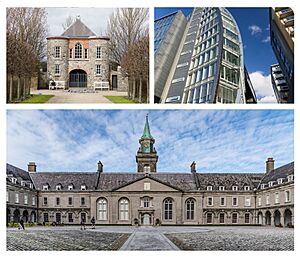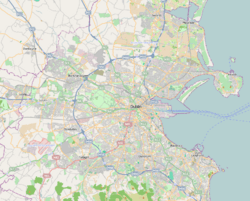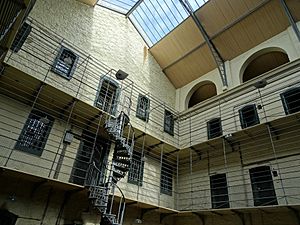Kilmainham facts for kids
Quick facts for kids
Kilmainham
Irish: Cill Mhaighneann
|
|
|---|---|
|
Inner suburb
|
|

Clockwise from top: The gardens at the Royal Hospital Kilmainham; Heuston South Quarter; the Irish Museum of Modern Art at Royal Hospital Kilmainham
|
|
| Country | Ireland |
| Province | Leinster |
| County | Dublin |
| City | Dublin |
Kilmainham (pronounced Kil-MAIN-ham) is a lively area in Dublin, Ireland. It is located just south of the River Liffey and west of the city centre. The name "Kilmainham" comes from the Irish "Cill Mhaighneann," which means "St Maighneann's church." It is part of Dublin's D8 postal district.
Contents
History of Kilmainham
Early Beginnings
Kilmainham started as a settlement way back in the early Christian period. A monastery called Cell Maignenn was built here by the year 606. This monastery was likely one of the first important buildings along the banks of the River Liffey.
An old piece of jewellery, called the Kilmainham Brooch, was found in this area. It is a special type of Celtic brooch from the late 700s or early 800s.
Vikings in Kilmainham
Around 841, Vikings settled in nearby Dublin. They also lived in Kilmainham, which was one of several villages along the river.
Large Viking cemeteries were found in Kilmainham and a nearby area called Islandbridge. These burial sites were discovered when people were digging for gravel or building railways and gardens. Dozens of Viking graves from the 800s have been found here. These graves contained items buried with the people, which was a Viking custom. Together, these sites form the largest known Viking cemetery outside of Scandinavia.
A battle called the Battle of Islandbridge happened here in 919. Viking forces, led by Sitric Cáech, defeated the Irish forces, led by High King Niall Glúndub.
Knights and Castles
In the 1100s, after the Normans arrived in Ireland, the land along the Liffey was given to the Knights Hospitaller. These were a group of knights who helped people and built hospitals. Strongbow, a famous Norman leader, built a castle for them about 2 kilometres (1 mile) from old Dublin. The Knights of St. John of Jerusalem owned this land until the 1500s.
For a long time, the Lord Lieutenant (the person who represented the English monarch in Ireland) often held court at the manor of Kilmainham. This was before Dublin Castle became the main centre of English power. In 1559, the building at Kilmainham was damaged, so the Lord Lieutenant had to move. Soon after, Queen Elizabeth ordered Dublin Castle to be improved, and Kilmainham became less important.
The Manor of Kilmainham was a special area with its own rules, separate from Dublin city. It included parts of James's Street and stretched quite far. Later, these special rights were removed, and much of the area became part of Dublin city.
Places to Visit in Kilmainham
Kilmainham is famous for several interesting places.
Royal Hospital Kilmainham
The Royal Hospital Kilmainham was built where the Knights of St. John of Jerusalem once had their main building. Today, it is home to the Irish Museum of Modern Art. This museum has many amazing modern artworks. The Richmond Tower is a landmark that connects the Royal Hospital to the South Circular Road.
Kilmainham Gaol
Close by is Kilmainham Gaol. This historic prison is famous because the leaders of the Easter Rising were executed here. It is now a museum where you can learn about Ireland's history.
Viking Burial Site
Kilmainham is also home to an important Viking Age burial site. Many items found here, mostly in the 1700s and 1800s, are now kept at the National Museum of Ireland. These items help us learn about the Vikings who lived here long ago.
The River Camac flows through Kilmainham. You can see bridges crossing it at the South Circular Road, Rowserstown Lane, and Bow Lane.
Railway Station
Dublin Heuston railway station, one of Dublin's main train stations, is located very close to Kilmainham.
Famous People from Kilmainham
Some well-known people who have lived in Kilmainham include:
- Katherine Lynch (born 1967), a television personality.
- Maeve Higgins, a comedian.
- Gina Moxley, a playwright.
- Brian Kennedy, a singer.
- Kathryn Thomas, a television personality.
See also
 In Spanish: Kilmainham para niños
In Spanish: Kilmainham para niños




